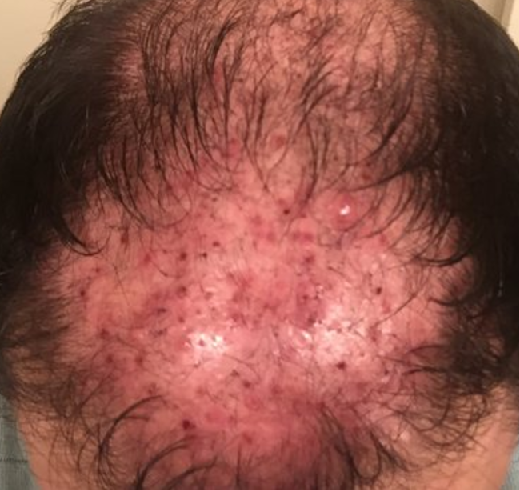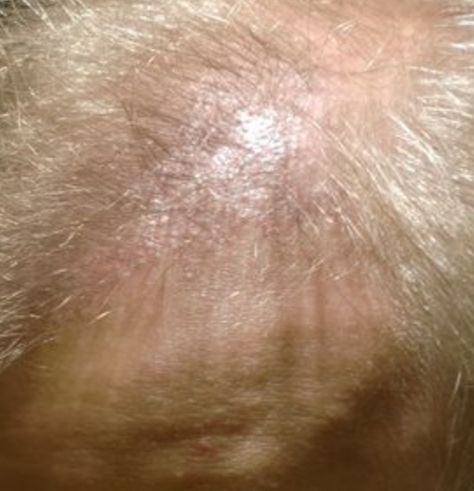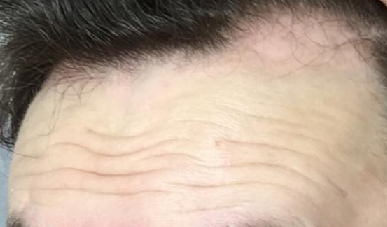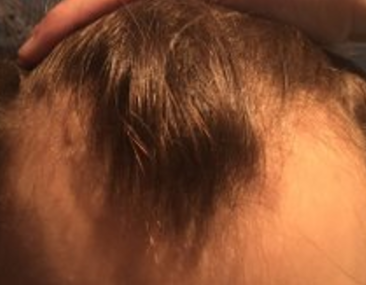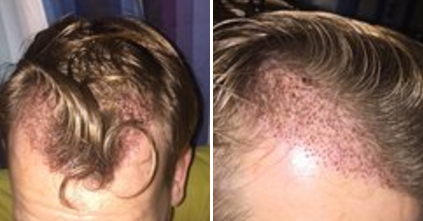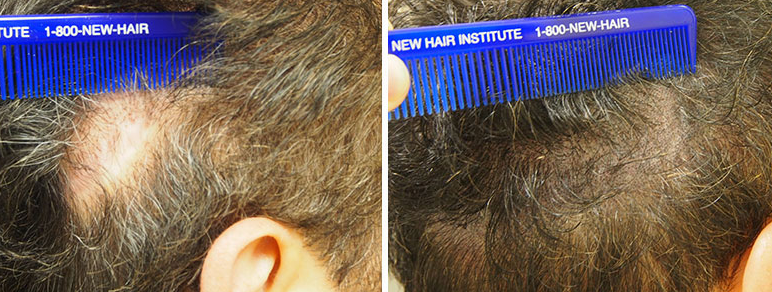I consulted with this 30 year-old man five years ago. At that time, he had frontal hair loss and did not want to take the drug Finasteride. The HAIRCHECK instrument showed no crown loss but today, five years later, he lost 50 percent of his hair in the crown since the test was last taken. Because his hair is so curly, you can’t see the crown loss very well in the photos, but had he taken the drug Finasteride, I doubt that he would have lost the crown hair had he taken the drug finasteride. The HAIRCHECK instrument is very sensitive in picking up early hair loss. He will go on the drug now to see if there is possible reversal of the crown loss which happens at times, but until a year passes, we will not know. He will get a hair transplant in the frontal area where the lines were drawn.
An estimated 20 per cent of Canadians (and 22% of Americans) have been tattooed, but what are the long-term effects? Scientists analyzed tattoo pigment samples from four corpses and two control subjects, and learned where tiny pigment samples ended up. When the pigment particles are small enough to go through the lung, they can end up in the brain as well.
This is a terrific story shown in photos in multiple surgeries. Congrats to the patient and the surgical team. It is important to note that the change was gradual, evidenced by the photos and I am sure that nobody saw the daily changes (like watching grass growing that you never see). People have always told me how surprised they were that nobody noticed, however, if anyone ever looked at an old photos, then they would know for sure.
I had my third epidural in my lumber spine and within a few weeks big chunks of hair started falling out, 1 patch of hair about size of a plum. Some days it’s fine then others clumps still fall out. I now have gone totally bald and it’s really affecting my depression and anxiety. I was wondering if anyone knows if it will grow back and how long as it’s near front so can’t hide it.
You need to see a doctor about your hair loss to find out if it is caused by medical conditions such as a disease entity or if it is purely genetic hair loss which can be accelerated by stress. Once you know, if the diagnosis is genetic hair loss and assuming that you are male, the drug Finasteride can maybe stop it. If it is from another disease, then you need a diagnosis. People who have conditions like you and who have stress from your primary problem (in your case your spinal problem) can cause the genes for hair loss to kick in and accelerate the hair loss that you may get in the years to come. Without pictures, it is impossible to know what you mean that you have gone totally bald so either send photos or see a doctor to make a diagnosis.
You clearly have significant folliculitis and need to see your doctor as soon as possible so that the infection does not kill off the grafts. Your doctor will take a culture, drain any pus pockets, put you on an antibiotic and judge the correctness of the antibiotic after the culture returns from the laboratory.
It is generally publicized that it is normal that a person can lose 100 hair a day on average. Other say that 100 hair a day is a lot and a normal loss is 50 hair/day or even less (20-30 hair/day) and that 100 hair/day is a sign of balding. Please can you advise if there were any trial to check how many hair on average a person really lose a day or if the 100 hair a day is based only on assumptions regarding number of hair in scalp and 10% in resting phase. Is this assumption of 100 hair/day credible and sure science. All the best and thank you for everything
Daily hair loss is part of the hair growth cycle. Hair essentially goes through two cycles. The Anagen Phase is the growth part of the cycle and it averages about three years. However, it often decreases with age and could be two or three years or even less the older you get. The second phase is called the Telogen Phase and it is the “rest” part of the cycle. The hair falls out while the hair root regenerates into a new hair that will regrow after about six months.
In a typical Caucasian who has 100,000 hairs on the head, assuming that the hair growth cycle lasts three years, divide number of hairs on the head by 1095 days and you come up with 91 hairs lost per day. In Asians with 80,000 hairs on their head, the number of hairs lost per day equals 80 percent of Caucasian numbers or 73 hairs per day, again assuming a 3 year growth cycle. A three year hair cycle, which may not be the case in older people, may be reduced, say two years instead of three years. Then the Caucasian hair loss per day would be closer to 150 hairs per day and the Asian hair loss per day would be about 120 hairs per day.
The real question is what will be your final hair loss pattern and will you have enough hair to follow the loss to its normal completion? Men under 25 are not good candidates for hair transplants. I consider doing a hair transplant on a 21 year-old the equivalent of malpractice on the part of the doctor. I would recommend that you seek other alternatives while your final balding pattern is established. Keep yearly contact with a caring doctor who will build a Master Plan for you, measuring your hair loss and possibly placing you on a drug like Finasteride which is very effective at stopping and often reversing hair loss in young men of your age. Just imagine, doing a transplant now, then losing more hair and doing another transplant in a year, then losing more hair and doing another transplant again in a year so by the time you are 24, you could have had 3 transplants and may continue to bald. The cost in using up your hair bank and your money bank are both the types of discussions you and your doctor must have when building a Master Plan for your future hair loss
Article: https://www.degruyter.com/view/j/hmbci.2017.30.issue-3/hmbci-2017-0015/hmbci-2017-0015.xml
Conclusion of this study
Our findings suggest that long-term dutasteride therapy produces worsening of ED, reduced T levels and increased glucose, HbA1c and alters lipid profiles, suggesting induced imbalance in metabolic function. We strongly recommend that physicians discuss with their patients these potential serious adverse effects of long-term dutasteride therapy prior to instituting this form of treatment.
Your donor area was either over-harvested if you had an FUE or developed a scar from a strip surgery which, when it occurs, usually occurs in that location. You did not state if you had FUE grafts and if so, how many or if you had strip surgery. If it was FUE, the number of grafts for that area was too high. If it was a strip surgery, most likely the wound was closed too tight which will cause this type of hair loss.
We obviously see complications from both (a) too many FUE grafts for a given area of the scalp and (b) strip wounds that are too tightly closed. Most doctors and patients think that the donor area can stand almost any stress but in this post I suggested that stress (FUE or strip surgery) can cause hair loss by impacting the donor area blood supply. You should wait this out and in about six months after the procedure, the hair may return. Scalp MicroPigmentation is a good option for this problem if it needs to be treated.
See link below.
https://scalpmicropigmentation.com/scar-covering/
I just had an FUE and want to know if I can use Minoxidil and when. Incidentally, is it true that there is benefit on using Minoxidil on the implanted hairs?
The use of Minoxidil on the recipient growth can be started once the crusts are all off. I ran a study on half of the head on a few dozen patients where I put Minoxidil on half of the head and not the other half. There was no value seen on the Minoxidil side.
Wow, your hair loss at this stage is an advanced Class 3 pattern but the real question is where is the hair loss going? Of course you can have a hair transplant now, then do another in a year and a year later do another etc., if you get what I am saying. You don’t want to be addicted to having hair transplants every year until you use up all of your donor hair and then have an incomplete job to show off, not good. At 18, we always discourage boys in going the hair transplant route. You need to consider yearly measurements with the HAIRCHECK instrument by a doctor who has one, then you also need to consider taking the drug Finasteride which is the only drug that MIGHT stop the hair loss. If your family history is one of advanced balding, then you and your doctor need to work out a Master Plan for your future with regard to hair loss, drugs and eventual surgery when you are much older.
Wait at least six months before transplanting a pox scar so that everything is healed before going forward with a hair transplant into the cheek. For a POX scar, Scalp MicroPigmentation is similar and faster with the results and probably much less expensive, see below. The picture shows a thumb size scar which was not transplanted but covered with Scalp MicroPigmentation, much smaller than the POX scar to which you are referring.
Page 359 of 636


